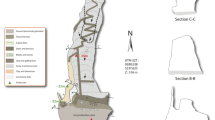Abstract
Two formulations of acrylic varnish, with and without either of two dry film biocides—one a mixture of isothiazolinones and benzimidazole derivatives, and the other a carbamate—were tested in vitro for their activity against mixtures of filamentous fungi and cyanobacteria found on sandstone buildings. Growth on filter-paper squares coated with the varnishes was assessed semi-quantitatively by naked eye, quantitatively by image analysis and chemically by measurement of ergosterol and chlorophyll a. The lower solvent content (higher resin) varnish was more inhibitory to cyanobacteria than the higher varnish content, whilst the opposite was true for the fungal inoculum. The carbamate biocide was effective against cyanobacteria, unlike the isothiazolinone mixture, but the latter produced more inhibition of fungal growth. The three assay methods produced generally similar results, although visual observation was obviously the most imprecise. There was an anomaly in the ergosterol measurements, which was considered to be caused by the varying ergosterol content and unequal inhibition of the three fungal genera used in the inoculum. Fusarium sp. was shown to contain higher levels of this membrane component than Cladosporium sp. and Penicillium sp. For this reason, the most appropriate method overall, giving reliable quantitative results, was deemed to be the image analysis.
Similar content being viewed by others
References
Allsopp D, Seal K, Gaylarde C (2004) Introduction to biodeterioration. Cambridge University Press, Cambridge, pp 177–191
Barrionuevo MER, Gaylarde CC (2005) Physiological and microbiological analyses in sandstones of the ruins of the Jesuit missions in Argentina. In: Ortega-Morales BO, Gaylarde CC, Narváez-Zapata JA, Gaylarde PM, (eds) LABS 5 Biodeteroration and Biodegradation in Latin America. Edición Universidad Autónoma de Campeche, Centro de Investigación de Estudios Avanzados del Instituto Politécnico Nacional, Campeche, p 21–24
Bravery AF (1988) Biodeterioration of paint—a state-of-the-art comment. In: Houghton DR, Smith RN, Eggins HOW (eds) Biodeterioration 7. Elsevier Applied Science, Barking, pp 466–485
Clausen CA, Yang V (2007) Protecting wood from mould, decay, and termites with multi-component biocide systems. Int Biodet Biodeg 59:20–24
De Muynck W, Ramirez AM, De Belie N, Verstraete W (2009) Evaluation of strategies to prevent algal fouling on white architectural and cellular concrete. Int Biodet Biodeg 63:679–689
Diez MALM, Barros NS (1992) Avaliação de microbiocidas para preservação de tintas [Evaluation of microbiocides for paint preservation]. In: Latorre W, Gaylarde C (eds) First LABS: Simpósio Latinoamericano de Biodeterioração. TecArt Editora, Sao Paulo, pp 106–120
Gobakken LR, Hoibo OA, Solheim H (2010) Mould growth on paints with different surface structures when applied on wooden claddings exposed outdoors. Int Biodet Biodeg 64:339–345
Gors S, Schumann R, Haubner N, Karsten U (2007) Fungal and algal biomass in biofilms on artificial surfaces quantified by ergosterol and chlorophyll a as biomarkers. Int Biodet Biodeg 60:50–59
Gutarowska B, Zakowska Z (2002) Elaboration and application of mathematical model for estimation of mould contamination of some building materials based on ergosterol content determination. Int Biodet Biodeg 49:299–305
Jacobson AH, Willingham GL (2000) Sea-nine antifoulant: an environmentally acceptable alternative to organotin antifoulants. Sci Total Env 258:103–110
Knudson L, Tibbitts T, Edwards G (1977) Measurement of ozone injury by determination of leaf chlorophyll concentration. Plant Physiol 60:606–608
Morton L, Lovell M, Mitchell A (1984) Effect of maceration on filamentous algae used for the testing of algicidal compounds. Int Biodet 20:33–36
Niemenmaa O, Galkin S, Hatakka A (2008) Ergosterol contents of some wood-rotting basidiomycete fungi grown in liquid and solid culture conditions. Int Biodet Biodeg 62:125–134
Prieto B, Silva B, Lantes O (2004) Biofilm quantification on stone surfaces: comparison of various methods. Sci Tot Env 333:1–7
Saad DS, Kinsey GC, Paterson R, Gaylarde C (2003) Ergosterol analysis for the quantification of fungal growth on paint films. Proposal for a standard method. JOCCA–Surf Coat Int B 86:131–134
Scheerer S, Ortega-Morales O, Gaylarde C (2009) Microbial deterioration of stone monuments—an updated overview. Adv Appl Microbiol 66:97–139
Shirakawa MA, Gaylarde CC, Gaylarde PM, John V, Gambale V (2002) Fungal colonization and succession on newly painted buildings and the effect of biocide. FEMS Microbiol Ecol 39:165–173
Souza A, Gaylarde CC (2002) Biodeterioration of varnished wood with and without biocide: implications for standard test methods. Int Biodeter Biodeg 49:21–25
Tretiach M, Bertuzzi S, Salvadori O (2010) Chlorophyll a fluorescence as a practical tool for checking the effects of biocide treatments on endolithic lichens. Int Biodeter Biodeg 64:452–460
Acknowledgments
The authors wish to thank the Brazilian funding body, CNPq, for a post-graduate scholarship to MREB and partial funding of materials for this project.
Author information
Authors and Affiliations
Corresponding author
Rights and permissions
About this article
Cite this article
Barrionuevo, M.R.E., Gaylarde, C.C. Biocide-Containing Varnish for the Protection of Sandstone: Comparison of Formulations and Laboratory Test Methods. Curr Microbiol 62, 1671–1676 (2011). https://doi.org/10.1007/s00284-011-9912-6
Received:
Accepted:
Published:
Issue Date:
DOI: https://doi.org/10.1007/s00284-011-9912-6




